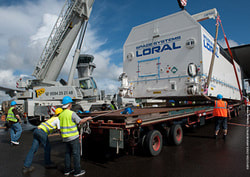
PALO ALTO, Calif. & GERMANTOWN, Md. – May 14, 2012 – Space Systems/Loral (SS/L), the world’s leading provider of commercial satellites, today announced that the EchoStar XVII satellite, designed and built for Hughes Network Systems, LLC (Hughes), a wholly owned subsidiary ofEchoStar Corporation (NASDAQ: SATS), has arrived at the European Spaceport in Kourou, French Guiana, where it will be launched aboard an Ariane 5 launch vehicle by Arianespace. One of the highest capacity satellites ever built, EchoStar XVII will be used to provide HughesNet® Gen4 high-speed Internet service in North America.
“Broadband access is essential for participation in today’s Internet economy,” said John Celli, president of Space Systems/Loral. “It has been our privilege to team with Hughes and apply our four decades of experience with Ka-band satellites to help make their vision of expanded high-speed satellite Internet access across North America a reality.”
EchoStar XVII, with JUPITER high-throughput technology, is an all Ka-band, broadband satellite designed to provide well in excess of 100 gigabits per second capacity to HughesNet’s rapidly growing subscriber base. Its multi-spot beam architecture will expand coverage and focus capacity on the areas with the highest traffic demand for enhanced services by consumers and businesses in North America.
“EchoStar XVII will bring HughesNet Gen4 high-speed Internet access to over 1.5 million consumer and small business subscribers, further securing our position as the world’s leading provider of satellite broadband services,” said Pradman Kaul, president of Hughes. “Space Systems/Loral has been an excellent partner in building this complex spacecraft and we are very excited to see it launch next month.”
Based on the highly reliable Space Systems/Loral 1300 platform, EchoStar XVII is designed to provide service for 15 years or longer. The satellite will be the fourth dedicated broadband satellite built by SS/L to orbit the earth.
About Hughes Network Systems
Hughes Network Systems, LLC (Hughes) is the world’s leading provider of satellite broadband for home and office, delivering innovative network technologies, managed services, and solutions for enterprises and governments globally. HughesNet is the #1 high-speed satellite Internet service in the marketplace, with offerings to suit every budget. To date, Hughes has shipped more than 2.8 million systems to customers in over 100 countries, representing over 50 percent market share. Its products employ global standards approved by the TIA, ETSI and ITU organizations, including IPoS/DVB-S2, RSM-A, and GMR-1.
Headquartered outside Washington, D.C., in Germantown, Maryland, USA, Hughes operates sales and support offices worldwide, and is a wholly owned subsidiary of EchoStar Corporation (NASDAQ: SATS), a premier global provider of satellite operations and digital TV solutions. For additional information about Hughes, please visit www.hughes.com.
About Space Systems/Loral
Space Systems/Loral, a subsidiary of Loral Space & Communications (NASDAQ: LORL), has a long history of delivering reliable satellites and spacecraft systems for commercial and government customers around the world. As the world’s leading provider of commercial satellites, the company works closely with satellite operators to provide spacecraft for a broad range of services including television and radio distribution, digital audio radio, broadband Internet, and mobile communications. Billions of people around the world depend on SS/L satellites every day. For more information, visit www.ssloral.com.
About Loral Space & Communications
Loral Space & Communications is a satellite communications company. Through its Space Systems/Loral subsidiary, the company is a world-class leader in the design and manufacture of satellites and satellite systems for commercial and government applications including direct-to-home television, broadband communications, wireless telephony, weather monitoring, and air traffic management. Loral also owns 64 percent of Telesat, one of the world’s largest providers of satellite services. Telesat operates a fleet of telecommunications satellites used to broadcast video entertainment programming, distribute direct-to-home video and broadband data services, and other value-added communications services. For more information, visit Loral’s Web site at www.loral.com.

